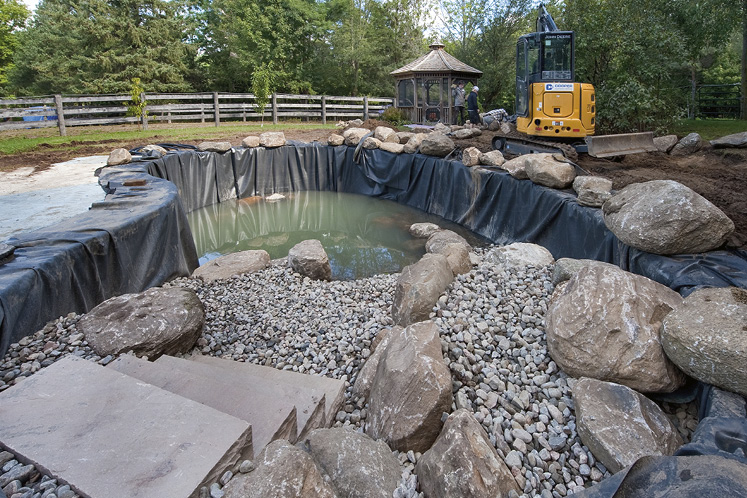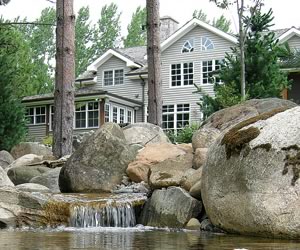From Pool to Pond
How a Mono nature lover transformed her swimming pool into a pond teeming with wildlife.
After living at her country home in Mono for a few years, Carol Terentiak remained enchanted by the country views and pleased with the horse barn that first drew her to the six-acre property in 2011. But she had never overcome her initial misgivings about its concrete swimming pool.
Carol’s children had grown, and while they occasionally brought the grandkids to swim, for the most part the 35-foot-long pool was an underused feature that required too much work.
“I rarely swam in it myself but did spend a lot of time cleaning it and dumping the required salt and chemicals into it,” says Carol. “The worst was in the fall when all the leaves from the trees made the pool their home.”
Fed up, Carol started researching how to transform the kidney-shaped curse into something more beautiful and biological – that could eventually be a habitat for wildlife. Though she found inspiration from similar projects in other countries, she struggled to find a company willing to embrace her “biopond” project. “I actually had one landscaper tell me I had a pretty enough place and to just fill it in,” she says.
But her perseverance paid off. In 2020, Fergus-based company July Ponds & Landscaping – known for creating water features and swimming ponds from scratch – got on board. Owner Chris July had never undertaken a pond project on a pool site before, but he was game.

The first step in Carol Terentiak’s pool-to-pond conversion was to install a rubber liner in the kidney-shaped pool. Photography by Rosemary Hasner.
“Converting an unwanted pool to a pond full of life is a great way to repurpose an existing space,” says Chris. “We were inspired and up for the challenge of creating an organic garden space where the waters are pure and promote life and positive spirits. Our goal was to create an organic balance within the pond so that it can sustain itself with little intervention.”
The first task was to prepare the pond’s base. The old pool liner was removed, and a layer of sand was added to cushion a new synthetic rubber liner. (Holes had been drilled into the pool base to drain any water that might seep between the liner and the concrete.) The pool depth ranged from about three feet to six feet. At the shallow end, wide steps were built to provide access for wildlife, as well as Carol’s dogs who love to swim.
On either side of the steps, large landscaping rocks and gravel were added to create a bed for aquatic plants, some of which grow directly in the gravel and some in planting pockets made with geotextile. Carol’s pond plants include water lilies, irises, pond grass, cattails, hornwort, arrowhead, horsetails and soft stem rush, plus two floating plants – water lettuce and water hyacinth – to shade and cool the water below.
Next, more rocks and garden plants were placed around the pool to naturalize its edges. The final touch was the creation of a charming bubbling brook which flows down a stone path to a waterfall at the pond’s deep end. It is part of a filtration system that circulates and aerates the water. According to Carol, “The goal was for the pond to eventually clean itself without any chemicals.”
With the plants in and the landscaping complete, Carol introduced the pond’s first residents – six goldfish – which quickly became dozens of goldfish. And with no other natural ponds nearby, it wasn’t long before the local wildlife began making themselves at home, exactly as Carol had hoped.
“In addition to my goldfish, now I’ve also got frogs and a painted turtle. I have no idea how the turtle got there – it just showed up, as did the frogs,” Carol says. Her domestic ducks use the pond, joined by the occasional wild duck. “So many birds come to the little river flowing from the waterfall to drink in the summer – robins, wrens, crows and more. It’s a treat each time I’m out there to wait and see what birds will stop by for a drink.”
One summer the pond also attracted a huge blue heron who couldn’t resist a feast of tadpoles and goldfish, but overall there aren’t a lot of predators, so the goldfish and frogs reproduce fast enough to maintain their populations. The goldfish also have their own little cave to hide in when they need to. “I’m happy different animals can thrive here,” Carol says, describing how she hated finding dead frogs that had become stuck and drowned in the leaf skimmer of the old pool.
The first year, however, was definitely a learning curve for Carol as the pond was hit with an algae bloom which had to be treated. “I had to learn to balance the ecosystem of the pond by adding a lot more plants, as well as natural bacteria,” she explains. Since then, Carol is pleased to report she hasn’t needed to add any other supplements to the water. That also makes it safe for her dogs who like to jump in to cool down.
The only time Carol gets into the water is when she must anchor or move the location of a floating fence that protects some of the plants. “If I don’t adjust the fence, the ducks will eat them – especially in the spring when they are new and tender.”
Now that the project is complete and the pond is thriving, Carol is thrilled with the results and takes great joy from her aquatic oasis. “I just love the sound of the waterfall, both in summer and winter. I love to see the migratory birds that visit in the summer. Each morning I look for frogs, tadpoles and baby fish to see where they may be hiding or swimming. The pond is a great place to sit, have a cold drink and read while listening to the waterfall. This is a place where I find peace.”
—with files from Alison McGill
Related Stories

No Ordinary Swimming Pool, No Ordinary Pond
Mar 23, 2008 | | LeisureIf you get the plants right, everything else pretty much falls into place.

Dispatches from a Vernal Pool
May 5, 2020 | | Notes from the WildVernal pools, like coral reefs, are theatres showcasing life and death struggles between prey and predators.









